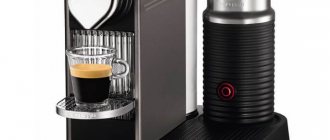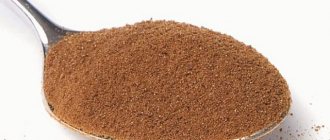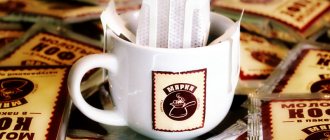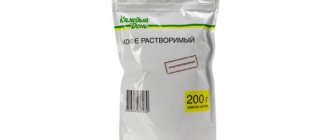Today on the “Beautiful and Successful” website we will talk about coffee. Millions of people start their morning with cups of aromatic coffee, which charges them with vigor for the whole day. And even more people start their day with a cup of some strange brown drink that is not at all invigorating and does not smell delicious, even though it is called “coffee.”
And how did it all happen? The fact is that some people know how to choose coffee , but others - alas! - No. That is why today’s article will talk about choosing delicious and high-quality coffee.
A little about varieties
There are a great many varieties of coffee in the world (to be more precise, experts number more than two hundred), but the main types are Arabica and Robusta. about Arabica : its taste is noble, its aroma is rich, and its piquant sourness is noticeable.
What kind of beast is robusta ? This coffee variety is less common than Arabica coffee simply because it is stronger and more bitter. This coffee also contains more caffeine than Arabica - many people love Robusta precisely for its powerful “invigorating” effect.
What does the name of the variety say?
And how does it happen that there are two main types, and so many varieties?
The fact is that the taste and aroma of coffee depends on the area in which the coffee tree grew. Everything matters: soil, water, the number of sunny days, plants growing next to the coffee plantation, and so on and so forth.
Therefore, the taste of Arabica from Africa will be very different from the taste of Arabica from South America. What about South America! Coffee from neighboring plantations can be very different from each other.
This is why it is worth looking at the full name of the coffee - it consists not only of the type of coffee, but also of the name of the country, city, mountain or valley where the coffee grew.
Often they even mention the port through which this coffee was sent to another continent.
Let's give an example. It is well known that the best mass-produced type of coffee is Brazilian Arabica Santos.
From this name it follows that this coffee is Arabica, it was grown in Brazil and was sent from a port called Santos.
Coffee: pros and cons
Until now, the opinions of doctors are very contradictory. Some, based on research, claim that your favorite invigorating drink is harmful to the heart, nerves and, possibly, other organs. Others vehemently deny this.
Such conflicting opinions are generally understandable: after all, of the proposed 2000 substances included in coffee, less than half are known, not to mention the fact that the physiological effect has not been studied. And people's individual reactions are very different.
In terms of its chemical composition and its stimulating effect, the main substance containing coffee has been best studied - caffeine. Caffeine primarily affects the human central nervous system.
Depending on the dose, it increases the pumping (blood emission) of the heart through the heart muscle, speeds up breathing and metabolism in general. Caffeine also stimulates kidney activity and increases the amount of urine produced. Blood vessels dilate, blood supply to all organs improves.
The blood vessels in the brain constrict and blood pressure temporarily rises.
The effect of caffeine is harmless for a healthy person, and even desirable for hypotensive people - people with low blood pressure. In addition, when drinking coffee systematically, the body seems to adapt to it, and blood pressure no longer rises. A complete abstinence from drinking coffee is now not necessarily recommended even for heart patients. A study conducted at the Harvard Institutes of Health (USA) found no relationship between drinking caffeinated coffee and an increased risk of heart attack or stroke. The paradoxical result of the study was that drinking “decaffeinated” coffee is associated with a greater risk of heart disease.
However, before the delight caused by the results of Harvard research that were beneficial for coffee and the heart had died down, a new trouble arose. In Scandinavia, coffee was found to increase blood fat levels. True, this statement is not new, but previously it was interpreted differently. Since people who drink coffee and have high blood cholesterol levels are often also heavy smokers, it was assumed that caffeine and nicotine interact to increase blood cholesterol levels. True, this relationship has not yet been completely refuted, but the “blame” of caffeine has weakened.
Grain, ground or granules?
So, how do we usually choose coffee? We come to the store, stand in front of the desired shelf and choose. If the store is large, then there is more choice - it becomes more and more difficult to decide.
The most important question: which coffee to choose? Grain, ground or granules? And how are they strikingly different from each other? The answer is simple: taste and smell .
Coffee connoisseurs unanimously say: if you want to drink high-quality coffee, buy beans or, in extreme cases, ground. And don’t even look at instant coffee.
They have exactly the same opinion about flavored coffee. Why buy coffee that has so many flavors added that you can’t taste the coffee itself, no matter how hard you try?
Next question: why is bean coffee better than ground coffee ?
After all, ground coffee is more convenient - you don’t need to waste time grinding it. The answer is simple: after grinding, coffee begins to lose its aroma and taste.
Laziness is the mother of knowledge
Until recently, driven by my laziness, I bought ground immediately. But, drinking mug after mug, I began to notice that the coffee was somewhat thin. And the grinding of the grain itself is either too coarse, or some kind of ballast substance is mixed in there. In general, something is wrong.
But one day I ran out of ground coffee, and I had to look in the bins, where I found the remains of beans. Having ground the grain into a fairly fine powder, I began to fill the cone. When filling, it turned out that the grind was wet, compacted well and stuck together, while the ground was dry. The coffee preparation time has also increased significantly. While ground coffee takes 5 minutes to brew, coffee from beans that I compacted too hard took 30 minutes to brew.
- The Comprehensive Guide to Roasting Coffee at Home
After pouring coffee into a mug, I discovered that the coffee became more viscous. Marks remain on the walls of the white mug for a long time, while the ground coffee quickly flows back. Let's try...
How to choose coffee by packaging?
So first we need to figure out why the way coffee is packaged matters.
It is known that after opening the package, coffee begins to “weather,” that is, lose its taste and aroma.
What happens if the packaging is not airtight enough? That's right, coffee will turn out to be tasteless already on the store shelf (if not in the warehouse). You don't want to buy tasteless coffee, right?
coffee packaging be like ? It all depends on what kind of coffee you need - beans or ground.
Packaging for grains
Coffee beans should be purchased in a multilayer vacuum bag with a one-way valve . Why is this valve needed? Some people believe that it was made to make it easier for customers to choose coffee in a store - they say, you smell it and understand whether you like it or not.
This is undoubtedly true, but the main purpose of the valve is to allow the coffee oil to evaporate. The fact is that coffee beans constantly release oil. And, if this valve were not there, the bag of coffee would simply burst.
Having learned about such a valve, many are perplexed: how is a package of coffee considered vacuum if there is some kind of hole in it? It is worth understanding that this “hole” is designed in such a way that it can let air out, but not let it in. Thus, if the rest of the packaging is intact, the valve prevents the penetration of oxygen.
Why is oxygen so scary? When oxygen comes into contact with coffee beans, an oxidation process - as a result, the taste of the drink can change greatly.
Do you want to choose good coffee beans? Make sure its packaging is airtight! In such packaging it can be stored without harm to its flavor and aroma properties for about a year.
Ground coffee
The sealing of the packaging is also important for ground coffee. Only it is best stored in vacuum briquettes - you've probably seen these in the store.
They are like little bricks that never change their shape (until you open the package).
Packaging without packaging
Coffee connoisseurs claim that the best coffee is sold by weight. Like, you can smell it, touch it, and evaluate its appearance.
In addition, loose coffee is often fresher than packaged coffee - of course, if it is sold in a place popular with customers, and not in Aunt Klava’s basement coffee shop, which the buyer wanders into once a year, and then by accident.
The best natural instant coffee in Russia and in the world: varieties, brands
1. Egoiste (4.7 points out of 5) . Quality instant coffee made from Colombian coffee beans and produced in Switzerland. Sold in the form of crystals, in which grains of ground coffee are hidden under a soluble shell. Thanks to this technology, the taste becomes more intense, but sediment remains at the bottom of the cup.
Instant coffee rating: No. 1 Egoiste
2. Bushido (5 points out of 5) . Premium coffee. Made from selected Arabica varieties. Edible gold is used in the preparation of Bushido 24 Karat. The beans for Black Katana are roasted over hot coals. And for Bushido Light Katana, coffee trees are grown on the slopes of Kilimanjaro. Coffee is elitist in every way.
Instant coffee rating: No. 2 Bushido
3. Jacobs (4.2 points out of 5) . The Jacobs company was founded in Germany, but now coffee of this brand is made at a subsidiary in the Leningrad region. Consumers choose Jacobs for good taste at an affordable price. In addition to Jacobs Monarch instant coffee, the company offers Jacobs Millicano, which contains both instant and ground coffee.
Coffee rating: #3 Jacobs
4. Lebo (4.3 points out of 5) . Instant Lebo Exclusive, originally from Colombia, is a fairly strong coffee, despite the fact that it contains only Arabica, Lebo “Extra” is Brazilian coffee with a chocolate note. The brand's products belong to the middle price segment and are sold in different packaging: vacuum, glass and portioned bags.
Coffee rating: #4 Lebo
5. Gevalia (4.7 points out of 5) . Coffee with a pleasant soft taste, without sourness or bitterness. Produced in Finland.
Instant coffee rating: No. 5 Gevalia
6. Nescafe (3.5 points out of 5) . The taste of Nescafe Classic is probably familiar to everyone. This is a soft, non-bitter coffee with chocolate notes. The brand's second most popular product is Nescafe Gold coffee, which is lighter and lighter in taste.
Instant coffee rating: No. 6 Nescafe
7. Today (4 points out of 5) . Coffee from the middle price category. Today Espresso has spicy notes. Today Green contains green, unroasted coffee beans and tastes like green tea. Today In-Fi has both instant and ground coffee.
Instant coffee rating: No. 7 Today
A little about where to buy
Since the website sympaty.net is talking about Aunt Klava’s underground shops, perhaps it’s worth saying a few words about where you should and shouldn’t buy coffee. It's no secret that we most often buy coffee in grocery stores - but where else? Well, grocery, so grocery.
How could this be dangerous? The fact is that coffee absorbs odors very well. That is why it is extremely undesirable to buy coffee that is in the store next to sausage, fish or, even worse, washing powder.
In general, if you want to drink truly tasty and aromatic coffee, I strongly recommend not to be lazy and go to a specialized store to buy it. There are no smells, there is more choice, the coffee is fresher, and - most importantly - friendly consultants will help even the most picky customer choose coffee.
Reviews from favorite customers:
Join us! Coffee and what you like)
The assortment of coffee today is very rich, for every taste. From such abundance, sometimes you can even get confused, which one to choose? Some people like strong, bitter coffee, others prefer a soft, subtle taste, while others serve coffee without caffeine at all, and for others with sourness. Whether it happened before! If you want an Indian one, or if you want a Brazilian one, if you can get it. People were especially chasing cans of Indian coffee, in iron cans, which were sometimes given out “in sets” at production sites for various holidays, along with champagne and a loaf of raw smoked sausage.
How to choose coffee to suit your taste?
And now we come to the most interesting part: how to choose the kind of coffee that tastes good?
There are no established rules here like: “all men like heavily roasted, coarsely ground Arabica, and all women like lightly roasted, medium-ground Robusta.”
Each person has his own preferences - this rule also applies to the choice of coffee.
But what determines the taste of coffee? The taste is determined by the type of coffee itself, the degree of roasting and the degree of grinding. We talked about varieties at the very beginning of the article, now it’s time for roasting and grinding.
Degree of roasting of coffee beans
What you need to know about roasting beans? The more recent it was, the better.
It is believed that the most delicious coffee is coffee that was roasted less than a month ago. But four months after roasting, not a single gourmet will drink this coffee.
So how can you roast beans?
- In Scandinavian style , that is, just a little bit (light degree of roasting). This roasting makes the coffee taste delicate and soft - this is the kind of coffee many people like to drink in the morning.
- Viennese (medium roast). The taste of the coffee becomes a little richer and a little sweeter. This coffee is suitable for any time of day.
- French style (high degree of roasting). After such roasting, the bitterness beloved by many appears in the coffee, and the coffee itself becomes velvety.
- Italian style (very deep roast). This produces the strongest coffee. The strongest, the most bitter and the most expressive. It is better not to drink this coffee in the afternoon.
Grinding
Grinding not only affects the taste of the coffee, but also how the drink is prepared. You can grind the beans yourself (it tastes better) or choose coffee that has already been ground (it’s more convenient). The main thing is to use this coffee correctly.
Grinding happens:
- Coarse (otherwise called coarse) - on average, the grains grind for about 10 seconds. Coffee grains can be about a millimeter in size. This grind is suitable for brewing coffee in a cezve or coffee pot. Also suitable for preparation in a piston coffee maker. This coffee should steep for about 7 minutes (otherwise the flavor will not fully develop).
- Medium – on average, grains grind for about 13 seconds . Coffee of this grind can be used everywhere - in coffee makers, in cezves, and in Turks. This coffee should steep for about 5 minutes.
- Fine – on average, grains grind for about 17 seconds. Coffee of this type is used in filter coffee makers. This coffee brews for only 3 minutes.
There is also a fine “espresso” grind - specifically for espresso coffee makers that pass a stream of steam through the coffee.
To prepare Turkish coffee, ultra-fine grinding is used, after which the coffee tastes most like flour.
Remember that after grinding, coffee begins to quickly lose its flavor and aroma properties. This is why experts recommend buying coffee beans in small quantities (no more than 200 grams at a time), and grinding them just before using them.
What kind of coffee does Turkish coffee make?
There are so many types of this drink that it’s not immediately clear what to expect.
It's definitely not espresso - you can brew very strong coffee, but it won't be traditional espresso because it's brewed under pressure. Rather, Turkish coffee is closer to Americano or filter coffee, but at the same time it is still different. If you take coffee that is “correctly” ground, that is, closer to the dust (and this is how it is prepared according to Eastern traditions), it will be thicker, denser, and richer than a regular Americano.
When preparing coffee in a Turk, a high head of dense foam should form, into which microparticles of coffee “dust” fall. In the East, it is believed that serving coffee without foam is disrespectful to guests. Foam forms in the neck, so it is important to take a Turk with a volume of one cup. If there are two people in the family who drink coffee, either take a large one for two and prepare a drink for two at the same time, or buy two small Turks. In a large one, it simply won’t be possible to prepare a canonical drink for one, since the liquid will not reach the level of the neck.
In principle, nothing bad will happen if you brew a portion of the drink in a large coffee maker, so you don’t have to immediately buy cezves for everyone.










